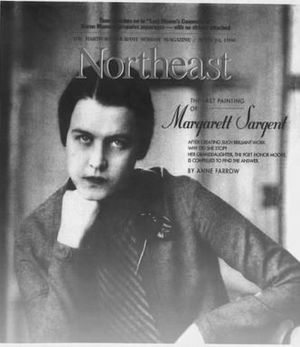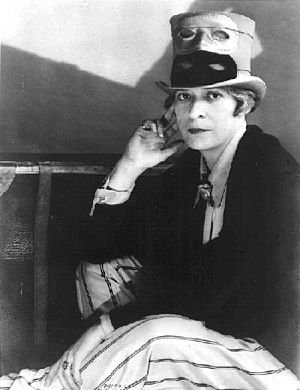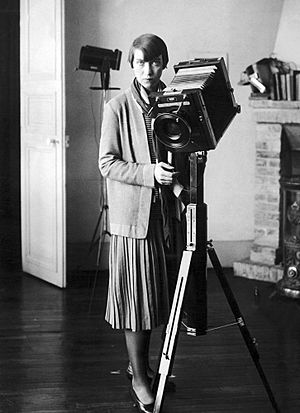Berenice Abbott facts for kids
Berenice Alice Abbott (July 17, 1898 – December 9, 1991) was an American photographer. She is famous for her portraits of artists and writers from the 1920s and 1930s. She also took many pictures of New York City's buildings and city life in the 1930s. Later in her career, she used photography to explain science.
Quick facts for kids
Berenice Abbott
|
|
|---|---|
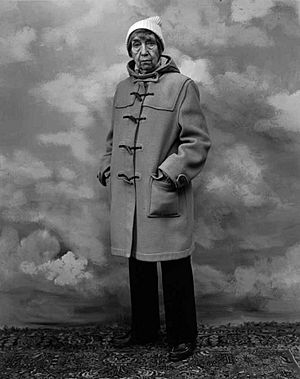
Abbott by Hank O'Neal in New York City, November 18, 1979
|
|
| Born |
Bernice Alice Abbott
July 17, 1898 |
| Died | December 9, 1991 (aged 93) Monson, Maine, US
|
| Resting place | New Blanchard Cemetery, Blanchard, Maine, U.S. |
| Nationality | American |
| Known for | Photography |
Contents
Early Life and Art Studies
Berenice Abbott was born in Springfield, Ohio. She was raised by her mother.
She went to Ohio State University for a short time. She left in 1918 when her professor was dismissed. She then moved to New York City. There, she studied sculpture and painting. In 1921, she traveled to Paris, France. She continued to study sculpture with Emile Bourdelle. While in Paris, she became an assistant to Man Ray, a well-known photographer. Man Ray taught her the basics of photography. Abbott took interesting portraits of other artists.
Photography in Europe
Abbott spent two years studying art in Paris and Berlin. She studied at the Académie de la Grande Chaumière in Paris. She also studied at the Prussian Academy of Arts in Berlin. During this time, she changed the spelling of her first name to "Berenice." This was suggested by her friend Djuna Barnes. Abbott also wrote poetry for an experimental magazine called transition.
Abbott started working with photography in 1923. Man Ray hired her as an assistant in his portrait studio. She later said, "I took to photography like a duck to water. I never wanted to do anything else." Ray was impressed by her work. He let her use his studio to take her own photos. Her first big exhibition was in a Paris gallery in 1926. After studying photography in Berlin, she returned to Paris in 1927. She opened her own photography studio there.
Abbott photographed many famous artists and writers. These included French artists like Jean Cocteau. She also photographed Americans living in Paris, like James Joyce. People said that if Man Ray or Berenice Abbott photographed you, it meant you were important. Her work was shown in exhibitions with other famous photographers.
In 1925, Man Ray showed her the photographs of Eugène Atget. Abbott became very interested in Atget's work. She convinced him to let her take his portrait in 1927. He died shortly after. Abbott then bought many of his photos and negatives. She worked hard to share Atget's art with the world. She helped publish a book of his photos in 1930. She also sold half of the collection to Julien Levy to get money for the project. Abbott continued to promote Atget's work until 1968. Her efforts helped Atget become famous around the world.
Changing New York Project
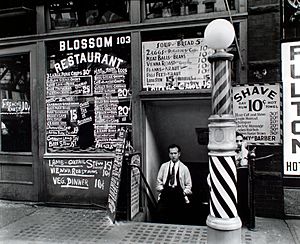
In 1929, Abbott visited New York City. She was amazed by how much the city was changing. She saw its potential for photography. She went back to Paris, closed her studio, and returned to New York in September. For the next ten years, she focused on taking pictures of the city. She wanted to show how New York was becoming a modern metropolis.
At first, Abbott used a small camera. But soon, she got a large camera that made big negatives. She used this camera to photograph the city with great care. She wanted to capture every detail, just like Eugène Atget had done. Her photos show many buildings and neighborhoods in Manhattan that no longer exist today. In 1937, her first exhibition in New York was called "Changing New York." A book with the same title was also published. It showed the city's physical changes, like old buildings being replaced by skyscrapers.
Abbott worked on her New York project for six years without financial help. She supported herself by doing commercial photography. She also taught at the New School of Social Research starting in 1933.
In 1935, the Federal Art Project (FAP) hired Abbott. She became a supervisor for her "Changing New York" project. This allowed her to focus on taking, printing, and showing her photographs. By the time she left the FAP in 1939, she had taken 305 photos. These photos are now kept at the Museum of the City of New York.
Abbott's project was a study of city life. She wanted to show how people, places, and daily activities in the city were connected. She hoped her photos would help people understand their environment. She often chose camera angles that showed the contrast between old and new buildings. She also used her photos to show what she approved of or disliked in the city.
Abbott's ideas about New York were influenced by writer Lewis Mumford. He wrote about how technology shaped American history. Abbott, like Mumford, was critical of the "paleotechnic era." This was a time after the American Civil War when cities grew rapidly without much planning. Abbott hoped that her photos could help people plan cities better. She wanted to create a more human-friendly "neotechnic era." She often photographed older buildings in ways that made them look threatening.
In 1935, Abbott moved into a loft with art critic Elizabeth McCausland. They lived together until McCausland's death in 1965. McCausland was a big supporter of Abbott's work. She wrote articles about Abbott and helped write the captions for the Changing New York book. In 1949, Abbott's book Greenwich Village Today and Yesterday was published.
A newspaper called PM said that Abbott's work was "the greatest collection of photographs of New York City ever made."
Abbott's photos of cities and buildings are often compared to those of Eugène Atget. Jerome Saltz, an author, noted that all three photographers found beauty in their subjects.
Beyond New York City
In 1934, Henry-Russell Hitchcock asked Abbott to photograph old American architecture. Two decades later, Abbott and McCausland traveled along U.S. Route 1 from Florida to Maine. Abbott photographed small towns and buildings related to cars. This project resulted in over 2,500 negatives.
After this trip, Abbott had a lung operation. She was told to move from New York City because of air pollution. She bought an old house in Blanchard, Maine. Later, she moved to nearby Monson. She lived in Maine until she died in 1991. Most of her work is shown in the United States, but some photos are also shown in Europe.
Abbott's last book was A Portrait of Maine (1968).
In 1943, Abbott was hired to photograph a lumber company in California. Some of these photos were part of a traveling exhibition.
Her Photography Style
Abbott was part of the straight photography movement. This style focused on taking photos that were not changed or manipulated. She did not like the work of "pictorialists." These photographers tried to make their photos look like paintings. Abbott's childhood experiences gave her the strength to follow her dreams.
Throughout her career, Abbott's photography showed the rise of technology and society. Her work documented and celebrated the New York landscape. She believed that a modern invention like the camera should be used to document the 20th century.
Scientific Photography
Abbott also helped create a company called "House of Photography." This company developed and sold camera equipment from 1947 to 1959. Abbott invented some things herself. One was a special easel that could create unusual effects on photos. Another was a telescopic lighting pole, now called an "autopole." This pole lets photographers attach lights at any height. The company eventually closed due to poor marketing.
Abbott's straight photography style was also useful for scientific photography. She once said, "We live in a world made by science. There needs to be a friendly interpreter between science and the layman. I believe photography can be this spokesman, as no other form of expression can be."
From 1958 to 1960, she took photos for a high school physics textbook. This textbook was created by the Physical Science Study Committee at MIT. Her photos showed things like wave patterns in water. She also took stroboscopic images of moving objects, like a bouncing ball. These photos helped explain physical laws and properties of solids and liquids.
Her scientific photos were later shown in an exhibition called Image of Physics. In 2012, some of her science work was displayed at the MIT Museum.
Personal Life
A film about Berenice Abbott called Berenice Abbott: A View of the 20th Century showed many of her photos. The film suggested she was a "proud proto-feminist." This means she was ahead of her time in her ideas about women's rights. She once said, "The world doesn't like independent women, why, I don't know, but I don't care." She openly identified as a lesbian.
She lived with her partner, art critic Elizabeth McCausland, for 30 years.
Berenice Abbott's life and work are the subject of the 2017 novel The Realist: A Novel of Berenice Abbott. A full biography of her life was published in 2018.
Works and Exhibitions
Famous Photographs
- Under the El at the Battery, 1932.
- New York at Night, 1932.
- James Joyce, 1928.
- Automat, 977 Eighth Avenue, New York, 1936.
- Radio Row, Cortland Street, Manhattan, c. 1936.
- The Hands of Jean Cocteau, 1927.
- Flatiron Building, Broadway and Fifth Avenue, New York City, 1938.
- Eugene Atget, 1927.
Books by Abbott
- 1939 Changing New York. (Later reprinted as New York in the Thirties, as Photographed by Berenice Abbott)
- 1949 Greenwich Village: Yesterday and Today.
- 1968 A Portrait of Maine.
Other Books with Her Contributions
- 1930 Atget, photographe de Paris. (She was the photo editor.)
- 1941 A Guide to Better Photography.
- 1963 A Vision of Paris: The Photographs of Eugène Atget, the Words of Marcel Proust.
- 1964 The World of Atget.
- 1964 Magnet. (With text by Evans G. Valens.)
- 1965 Motion. (With text by Evans G. Valens.)
Solo Exhibitions
Abbott had many solo exhibitions throughout her career. Some notable ones include:
- Weyhe Gallery, New York, NY, November 1930
- Photographs by Berenice Abbott at Julien Levy Gallery, New York, NY, 1932
- Changing New York at Museum of the City of New York, New York, NY, 1937–1938
- Berenice Abbott, The Museum of Modern Art, New York, NY, 1970–1971
- Berenice Abbott: The 20s and the 30s, International Center of Photography, New York City, 1981–1982
- Berenice Abbott, Photographer: A Modern Vision, The New York Public Library, New York NY, 1989–1990
- Berenice Abbott: Photography and Science: An Essential Unity, MIT Museum, Cambridge, Massachusetts, 2012
Collections
Abbott's work is held in many permanent collections, including:
- New York Public Library
- Museum of the City of New York
- Smithsonian American Art Museum
- The Phillips Collection, Washington, D.C.
- International Photography Hall of Fame, St. Louis, MO
- National Portrait Gallery, London UK
Images for kids
-
Pennsylvania Station (1936)
-
Detail of Manhattan Bridge (1936)
-
Wanamaker's department store, Fourth Avenue and Ninth Street (1936)
-
Flatiron Building (1938)
-
Hardware store on the Bowery in Manhattan (1938)
See also
 In Spanish: Berenice Abbott para niños
In Spanish: Berenice Abbott para niños


